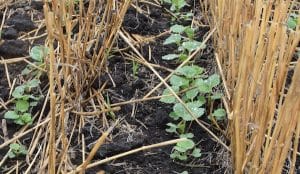Only about 50 to 60 percent of canola seeds typically emerge to form plants. Adopt the following best practices to maximize canola seed survival.
A canola stand that emerges uniformly, achieving five to eight plants per square foot, not only withstands flea beetle attacks better but also facilitates more efficient fungicide application and harvesting, ultimately leading to a higher yield and increased profits.
Rotate crops
A tight canola rotation could increase the risk from seed and seedling diseases that can prevent emergence or weaken the young plants.
Seed into warmer soils
Soil temperatures of 5°C or higher with warmer weather in the forecast should facilitate reasonably good rates of seed survival and emergence. The clock starts running on seed treatments as soon as the seed takes in water and begins germinating, so rapid emergence means that there will be a bigger window of protection from flea beetle for above ground growth.
Seed at around 1″ depth
Half an inch to 1″ below the packer furrow is the recommended seed depth for canola. This will reduce days to emergence and reduce the seed energy required for emergence. One inch depth is also the recommended start point in dry soils.
Level the drill
For some drills, the overall average may be one inch, but the range could be zero to two inches. The result can be highly variable emergence date, reduced seed survival and an uneven field. Follow the operator’s manuals to level the drill, check that openers are in good shape and inflate tires to the same pressure. This PODCAST provides some useful tips to make sure the seeding tool is level.
Seed slower
At higher speeds, rear openers tend to throw more soil over the front rows, making these seeds slower to emerge. At higher speeds, the whole seeding tool is less likely to cut smooth, even seed rows. The Canola Encyclopedia has a section on equipment management for better seed placement. AAFC research scientist Bob Blackshaw reported that increased seeding speed reduces the precision of canola seed placement, which can and thereby reduce emergence, regardless of the opener used.
Limit seed-placed fertilizer
Seed-placed fertilizer can increase seedling mortality. The safest practice is to place only phosphate fertilizer with the seed at rates up to 20 pounds of phosphate per acre. Higher soil moisture will protect seedlings somewhat from higher rates. Right rates for seed-placed fertilizer
Penetrate residue
Use openers and drill settings to penetrate residue so all seeds go into the soil. Residue should be spread evenly across the soil surface during or after harvest the fall before seeding canola. (Watch the video below.)
Pack appropriately
In wet conditions, reduce packing pressure to limit hard crusting. In dry conditions, pack more to conserve moisture in the seed row and ensure adequate seed-to-soil contact. Residue cover can also influence packing. More residue could benefit from increased packing pressure.
Tools to calculate emergence percentage
To measure on emergence percentage, count plants in each field at around the two- to four-leaf stage. At this time, all plants that will contribute to yield have emerged. Enter plant density, seeding rate and TSW for each field into the emergence calculator at www.canolacalculator.ca and record the result for each field. VIDEO on how to use the calculator.
Does seed size matter?
Seed size, given as thousand seed weight (TSW) in grams, will influence the seeding rate required to achieve a target stand. Use the tools at canolacalculator.ca to find the seeding rate (in lb./ac.) based on seed size, target stand and estimated emergence percentage.
An AAFC study “Seed size and seeding rate effects on canola emergence, development, yield and seed weight” (2014) led by Neil Harker concluded that seed size did not have any significant effect on emergence, yield or seed quality. The study used one variety of canola screened to segregate different seed sizes from the lot. Preliminary germination tests indicated that germination exceeded 97% for all seed size groupings for this study. The study did show that plants from the larger-seed grouping had increased early-season biomass and their flowering period started and ended a little earlier. But higher seed density can also increase early season biomass and also increase stubble density at harvest. That same study from Harker concluded that “higher seeding rates also increased early crop biomass, TSW and seed oil content, and reduced days to start of flowering and days to crop maturity.”
For more research on this topic, check out: Optimal seeding rate based on seed size in canola and Assessment of seed germination and seedling performance of spring canola at low temperatures.

